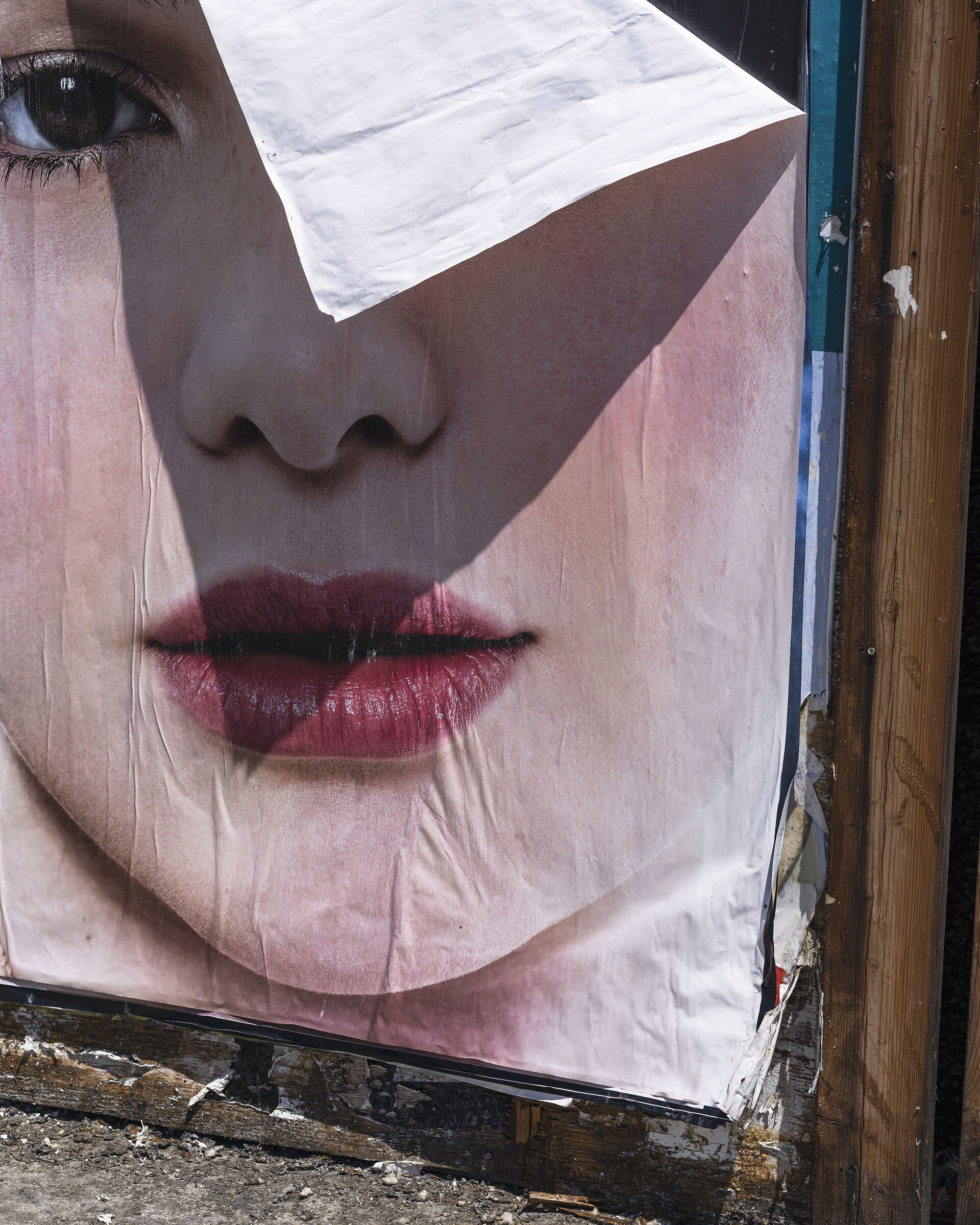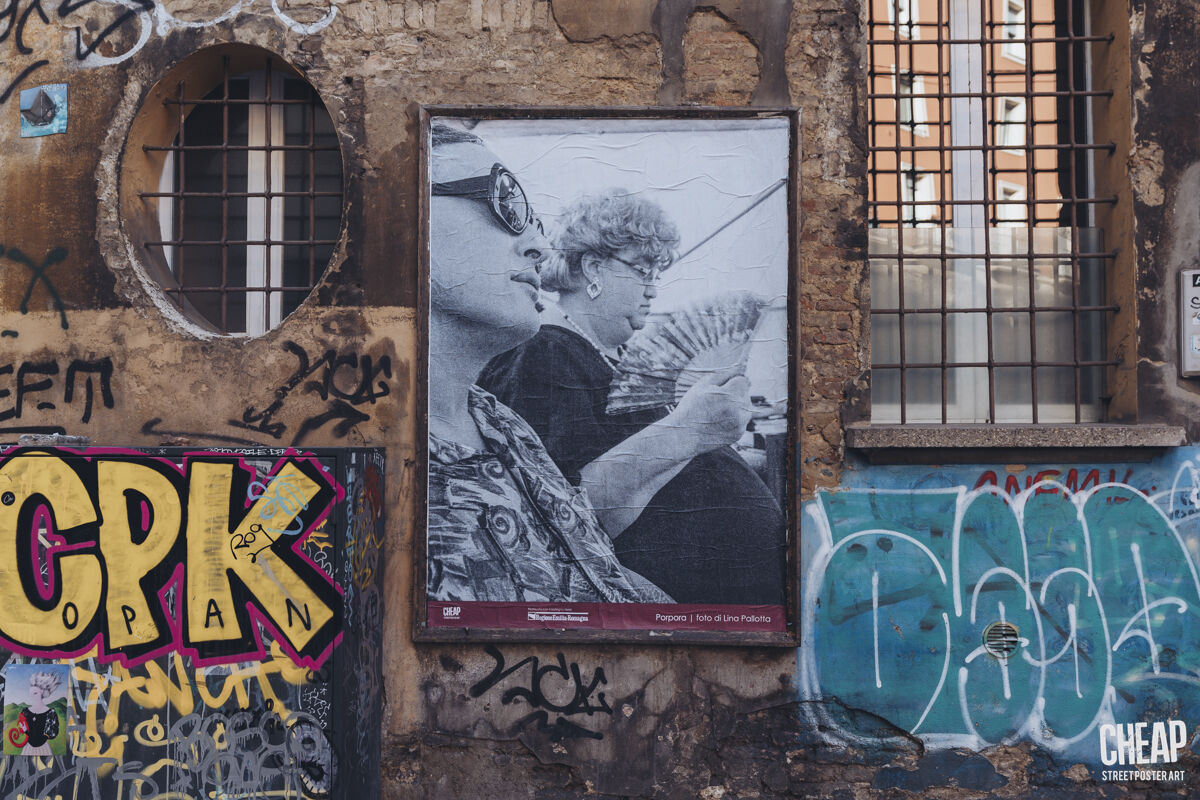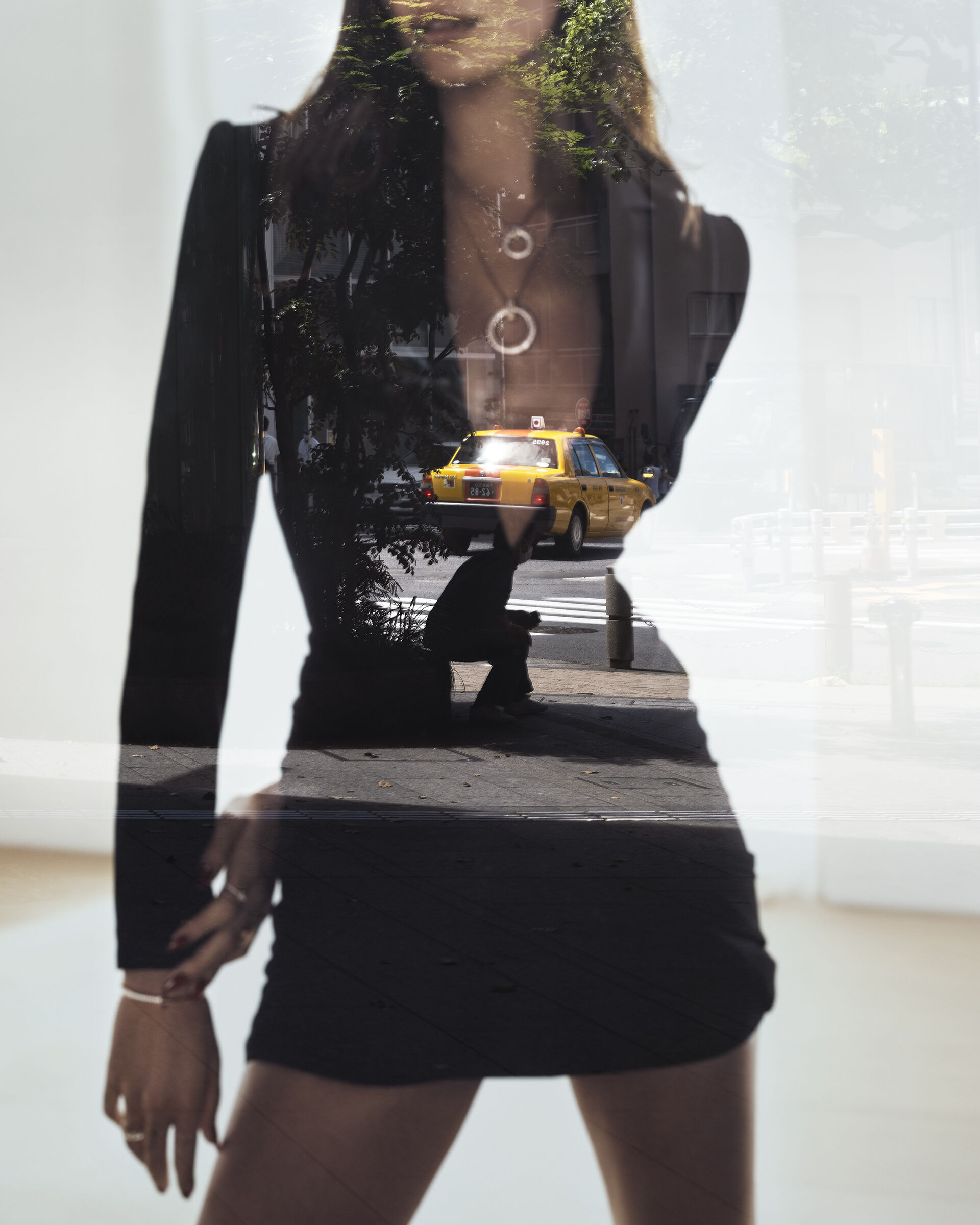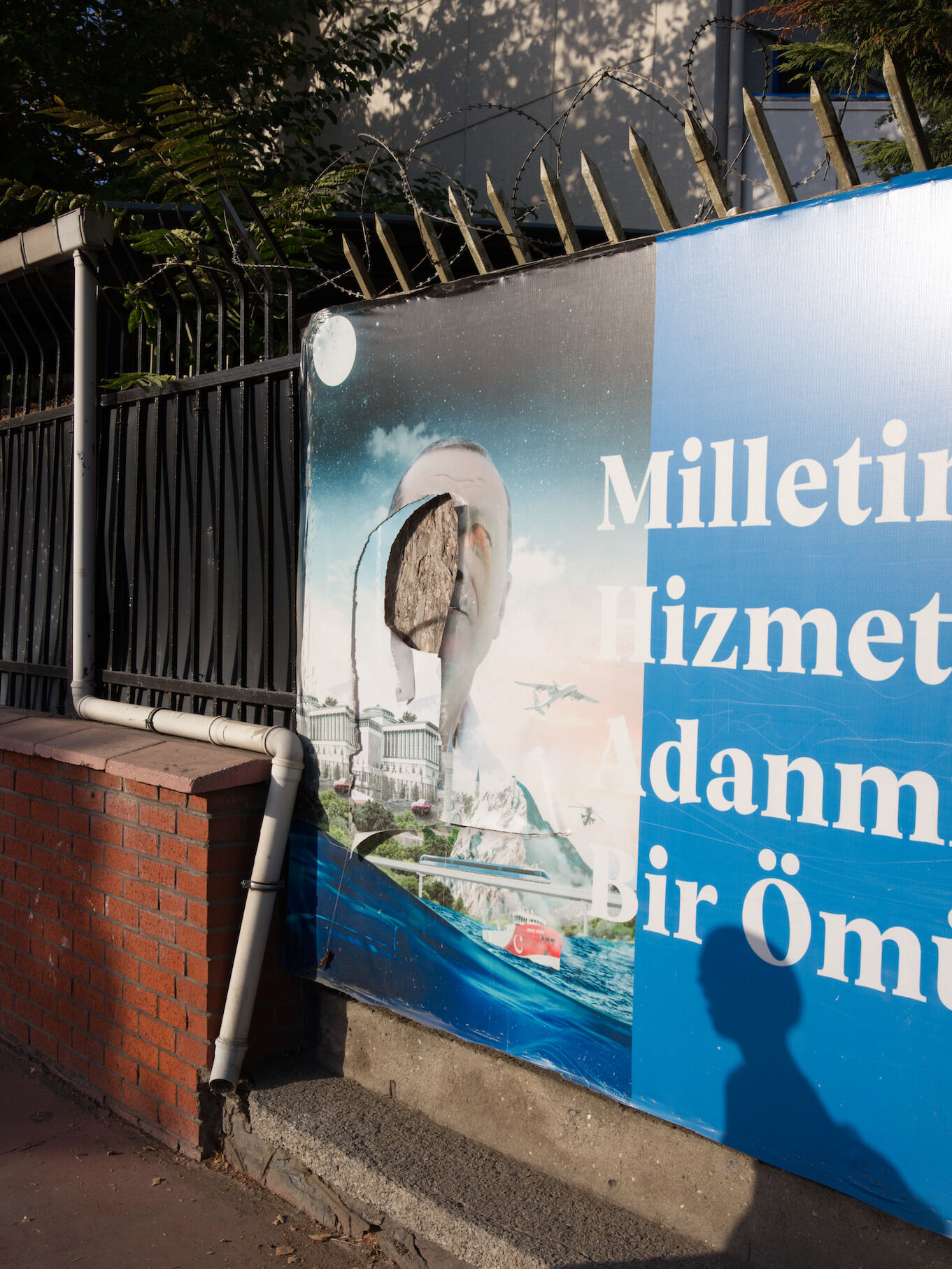I have repeatedly wondered whether my visceral and hypnotic interest in photographic images in public spaces could actually be a topical issue, or it was instead an anachronistic whim dictated by a personal fascination. Then, when reading Victor Burgin’s The Camera: Essence and Apparatus, I found the answer. In the introduction, the British author asserts that what specifically interests him is the place photography occupies in everyday life,Victor Burgin, The Camera: Essence and Apparatus (MACK, 2018), 9. that field of action where photography plays a fundamental role for ‘the formation of the ideas, beliefs and values according to which people live.’Burgin, 9. The peculiar characteristic of photography, for better or for worse, is precisely that of being perceived ‘as an environment’, blending into the most common, and for this reason invisible, forms of its own existence. Indeed, photographs – infused and embedded in the surroundings – facilitate ‘the formation/reflection/inflection of what we take for granted’.Victor Burgin, ‘Looking at Photographs’, in The Camera: Essence and Apparatus (MACK, 2018), 29. In Burgin’s words, photographs present themselves to us as offers we can’t refuse, and this is undoubtedly still valid today. While it’s true that in the modern era this happens mainly in the extended version of the canonical public space, i.e., the net and virtual world, the everyday physical environment continues to be significant in the way we approach images and their derivations. In the scopic regime in which we live, it’s us
who are looked at by images and devoured by them, still often unconsciously. It happens when we choose a book because of its cover, when we walk down the street and turn our gaze towards a shop window, or when we passively absorb the advertising image of a large billboard that towers above us – small pawns of society.

'Peeling Poster', from Image Cities, Los Angeles, 2022 © Anastasia Samoylova
Dwelling on the last of these, I look at billboards as one would alien creatures, fascinating and intimidating. In their apparent familiarity of architectural form, it’s profoundly interesting how within their frame (but also outside and surrounding it) kicks a wealth of illuminating discourses and visions about how images work and how they’re perceived. The billboard is, for me, a Pandora’s box. The deeper I delve into it, the more I uncover its boundless potential as a tool for exploring the mechanisms that govern how we interpret and engage with images, both in our everyday existence and in broader contexts. The billboard is, for all intents and purposes, a metalinguistic apparatus that can help us study certain peculiar characteristics of communication and art, following Lawrence Alloway’s view in which art and mass media are conceivable as a continuum.Quoted in Harriet Senie, ‘Disturbances in the Fields of Mammon’, in Billboard: Art on the road, eds. Laura Steward Heon, Peggy Diggs, and Lisa Dorin (MIT Press,1999), 25.
In today’s technology-driven society, billboards might appear as little redundant, nearly obsolete urban structures, thus seeming out of touch with our modern world steeped in virtual and multichannel dimensions. But I found that, contrary to what one might think, the billboard advertising business is by no means declining. These massive modern ‘monuments’ continue to play a fundamental role in the dissemination of sales-driven and propaganda-laden messages, influencing our imagination and our capacity to foster critical thinking. In essence, they shape our civic awareness – rarely for the better.

'Beauty Advertisement', from Image Cities, Vienna, 2022 © Anastasia Samoylova
This is precisely what emerges from Anastasia Samoylova’s most recent photography project Image Cities, which deals with the theme of the advertising image in public space. With a background in environmental design and as a shop window decorator, the American artist has always been drawn to urban morphology and the role images play in shaping the identity of cities. In particular, in this latest series, she focuses on the representation of female bodies in the cityscape. Looking at her photographs, on one hand, we see real women, often with smartphones in their hands (highlighting that extension of public space from an urban environment to a virtual world), depicted as subjects in the background of the giant advertisements that envelop them like a theatre backdrop. On the other, the symbol-women, models whose faces are printed in large format and whose intermittent fragments can be glimpsed, embedded in buildings, shop windows, and signs, contemporary trompe-l’oeil that wink at passers-by with the sensuality of their bodies.
Although the role of women in advertising has already been debated at length, the topic is not yet exhausted – quite the contrary. Projects like Samoylova’s are crucial because they remind us how, for women, ‘it is easy to feel targeted by the ads while not measuring up to them in our everyday lives’.Interview held with the artist via email, February 2024 Observing this work, it’s evident how this commodifying imagery contributes to moulding the space we inhabit – a realm that primarily caters to the male perspective, thereby marginalising women from truly experiencing it. The highly sexualised advertising decorates public space in a way that imbues the outdoors with male concepts of sexuality,Lauren Rosewarne, ‘The Men’s Gallery: Outdoor Advertising and Public Space: Gender, Fear, and Feminism’, Women’s Studies International Forum 28 (2005): 70. significantly impacting the way we learn to navigate womanhood. This fact is obviously not new, but has been an established approach for more than sixty years. The outdoor promotional image, in its various forms, continues to exploit the woman’s body as a sales trigger – and so does the billboard, the true ideological totem of metropolitan society. It’s precisely the monolithic, essentially commercial nature of the billboard that makes it a perfect device for those artists whose work radically reflects on the dismantling of dominant ideologies and the pitfalls of visual culture.
The billboard as a ground for creative exploration is a well-established practice: the artists make their way into the urban landscape by triggering interference in the visual field, producing short circuits and disruptions aimed at the production of new meanings. As ‘artists’ billboards enter the visual culture of the road at the risk of invisibility’,Senie, 22. they often employ a language that diverges from the hegemonic, playing on certain subtleties that remix semantic codes to create new interpretations of reality. Famous are the works of Barbara Kruger, Félix González-Torres, or Jochen Gerz, practices developed in the 1980s and 1990s, which then saw an interesting evolution leading to the creation of entire cultural projects based on the display of artworks on billboards.See, for instance, The Billboard Creative, and photographic festivals almost entirely developed on billboards, such as CONTACT Photography Festival or Capture Photography Festival, both in Canada.
In addition to this use of the billboard as an exhibition space, one can often trace an obsessive focus on this subject in the history of photography. Searching back in time for similarities to the latest work of Samoylova, it’s impossible not to notice a resemblance with Luigi Ghirri, the well-known Italian photographer who devoted his entire artistic career to examining the relationship between the physical world and the world of images. Through his ‘photographs of photographs’ (which we can find especially in the series Cardboard Landscapes and Kodachrome), but also through his writings (similar to what Victor Burgin was doing in the same period), Ghirri brings into play a reflection on the mechanical nature of perception and the passive consumption of images in everyday life. According to him, the multitude of commercial and decorative images on walls, in shop windows, and in urban interstices that pass by often unnoticed constitute a fresco of our times – similar to the mural paintings in churches and historic public buildingsLuigi Ghirri, ‘KM 0,250’, 1973. Niente di antico sotto il sole (Quodlibet, 2021), 41. – capturing the popular iconography of modern Western culture. In Ghirri’s visual investigation, advertising posters act not only as a backdrop but also as a real research ground. The subjects of the juxtapositions between real and fictitious images are often women (or fragments of women), showing the proliferation of the woman’s body as an advertising subject in the 1970s and ’80s – which is quite similar to Samoylova’s work. Both their gazes dwell on the presence of women’s fictional bodies in public space, with an implicit reference to how real one may experience and perceive the public space accordingly.
Going even further back in time, in Samoylova’s photographs, we can trace reminiscences of other authors who have looked at the billboard as a symbol of Western – especially American – society. Undoubtedly, the foremost figure that springs to mind is Walker Evans, who held a profound fascination for signs over the course of his career as a photographer pioneering the decoding of advertising communication. Interestingly, the connection between these two artists – although not exclusively related to billboards – has been previously investigated in a book called Floridas, illustrating how both artists captured the streets of the southern state as emblematic of the contradictions within the United States.Anastasia Samoylova and Walker Evans, Floridas, ed. David Campany (Steidl, 2022). In ‘Billboard, Birmingham, Alabama’ (1936), one of Evans’s most famous images on the subject of billboards, the artist crafts an ironic interpretation of a publicity device through deceptive simplicity. On the billboard’s irregular surface, a hand-painted depiction of an ‘American dream home’ disregards conventional rules of perspective and realism, resulting in a picture with almost childlike naivety. By directing his gaze towards this alienating image, Evans appears to articulate the sense of strangeness and unreality that the promise of luxury and comfort likely held for the rural poor impacted by the Great Depression.
Also worth mention is Margaret Bourke-White’s famous picture ‘At the Time of the Louisville Flood’ (1937), a powerful depiction of the gap between the propagandist representation of American life and the economic hardship faced by minorities and the poorer classes in the context of the Ohio River flood of 1937 in Louisville, Kentucky. Last but not least, there is the perhaps lesser-known image ‘Women in Front of Billboard’ (1949) by Louis Faurer, where the dramatic tagline of the billboard, alluding to the theme of unwanted pregnancy, contrasts with the blank expressions of the women in front of it, lost in thought, once again raising questions about the role of women in society.
These images have gone down in history precisely because they reflect how the billboards were ‘points of ironic contrast between the lifestyle portrayed in the advertisements and the existence endured by millions of Americans.’Senie, 16. These authors turned their attention primarily to the image hosted by the billboard, drawing attention to the ideological bearing of these devices, to the deceptive nature of the photographic image and the heterogeneous complex of codes that contribute to its interpretation.



Billboards, 2008 © Maurizio Montagna
Conversely, there is another branch of artistic research that plumbs the structural configuration of the advertisement display, omitting explicit reflection on the images that it hosts and therefore addressing ‘the billboard issue’ through a more conceptual approach. Indeed, by focusing on the billboard’s functioning as a frame positioned (and participating) in the city’s visual clutter, These artists unmask the ability of these chameleon-like objects to influence the stratification of our gaze. This approach includes the singular work of the Italian photographer Maurizio Montagna, who since 2003 has been continuously researching the symbolic role of the billboard as a semantic construct. In Billboards, through a process of taxonomic cataloguing, Montagna examines the advertising frame devoid of its original purpose, establishing a methodical and serial compilation of vacant billboards captured in both urban and suburban areas of Milan. The repetitive succession of images with the same subject, similar but different, alters the receivers’ perception, prompting them to adopt novel codes for interpreting the form and function of the billboard. The mimetic apparatus of the billboard thus becomes a subject, stripped of its outer layer (the image) and made an image in its own right. Building on this six-year project, Montagna subsequently embarked on other endeavours exploring the theme of billboards, venturing into installative and performative directions.
Caroline Hake’s work develops in the opposite direction to Montagna’s. In her project Decollage
(1997), she swapped advertising posters on ten billboards in Berlin-Mitte, replacing them with simulated views of architectural structures behind them and giving the illusion of seeing through the billboards to hidden buildings, walls, or green spaces.Maik Schlüter, ‘Billboards’ in: Billboards - Maurizio Montagna (Damiani, 2008). A similar approach, in terms of attention to the structure, can be traced in Stephen Gill’s Billboards
(2002–2004). The British artist dedicated one of his projects to the structural configuration of the billboard, making a further discarding action: he turns his gaze to the back of the structure, revealing the architectural scaffolding that holds up the commercial fantasies of the brands that rely on it for their communication.
In the context of contemporary developments, among the most recent and significant works is certainly that of Alexander Rosenkranz, a young, Berlin-based artist who examines issues related to architectural and social spaces on both global and local scales. His research is particularly interesting for its dual approach that brings together the artistic processes and perspectives we’ve seen so far. Rosenkranz’s photographs dwell on the precarious nature of advertisements in the urban background, framing lacerations of images and crammed modern landscapes. His gaze dwells on the ‘ephemeral materiality of billboards, the fast-moving nature that is primarily centered around the moment and the surface’,Interview with the author via email, January 2024. by emphasizing the billboard’s role as a straightforward and low-threshold image medium that finds its natural function in the constant interaction and confrontation with our gaze and the public environment. His investigation synthesises nearly all the ideas put forth by the authors discussed in this article, as it underscores the inherently material nature of the image, whose fruition depends on an inevitable engagement with its surroundings, and at the same time exemplifies the efficacy of the billboard as a vehicle for thinking about the functioning of visuality in our world – as he argues, ‘billboards make it accessible to understand what images do to us humans.’Interview with the author.
In fact, these intimidating presences that still loom over our heads today are an invaluable source of reflections on the polysemic, ideological, and ambiguous nature of the photographic image, whose ‘meaning goes beyond its manifest elements’,Victor Burgin, ‘Photography, Phantasy, Function’, in The Camera: Essence and Apparatus (MACK, 2018), 66. always depending on the context and form in which it appears in the world. For this reason, one might think of billboards more as allies than enemies. Admittedly, that’s how I see them – allies that aid in examining the intricate phenomenon of visual culture, which, although now a well-established and extensively studied field, still reveals noticeable gaps in the education of a public largely uninformed on this subject. The potential of billboards lies precisely in their inherent accessibility. They serve as spaces for contemplation readily available to all, fostering open discourse on unmediated perceptions of visual content and the everyday imaginary that embraces our field of vision in public space. And specifically here lies the crux of the question. Unpacking the meaning of billboards and their relationship to photography is a first step towards reclaiming public space, which in its current configurations increasingly fails to accommodate individual needs, let alone those of minorities.

CHEAP – PORPORA, photo by Lina Pallotta, Bologna. © Giulia Rosco
Here I think it’s worth mentioning Lina Pallotta’s open-air exhibition organised by CHEAP in Bologna in 2023, which showed images of Porpora Marcasciano, an historical figure of Italian transfeminism and an LGBTQ+ activist. On that occasion, twenty-five portraits by Pallotta papered the walls of the city centre in advertising frames, bringing the face of Marcasciano to the street together with the intimate experience of a community that has often fallen into oblivion, erased from history and made invisible to the eyes of most. This project strongly clashes – yet somehow builds a bridge – with Samoylova’s, where the woman’s representation is so gigantic and imposing that it transcends the gaze and reaches directly into the mind, infiltrating our thoughts and the way we conceive ourselves. In this sense, Pallotta’s exhibition shows that bringing counterstories to the street is an act of resistance and reappropriation of our shared living environments. In such a historical period dominated by individualism and fear of the other and the different, it’s time to conceive a conscious, inclusive shape for our public space, one designed for the plurality of people who inhabit that space and coexist with the images that permeate it.
The arguments raised by a conscious examination of the mechanisms governing the circulation of images in public space can help us, at least in part, to untangle the complex journey of reclaiming the environment we inhabit, fostering a sense of ownership and comfort in shared spaces. As stated by Martha Rosler, ‘cultural products can never bring about substantive changes in society, yet they are indispensable to any movement that is working to bring about such changes’.Martha Rosler, ‘For an Art Against the Mythology of Everyday Life’, in Decoys and Disruption: Selected Writings, 1975–2001 (MIT Press, 2006), 8. That’s why it’s crucial to reflect, even today, on the role of billboards in the society of images. Whether we look at them from a historical or a contemporary perspective, they can teach us a lot about our relationship with photography and how photography teaches us to be in the world, consciously or unconsciously.
And if it’s a personal obsession, well yes, perhaps it is. But our obsessions often represent our times more accurately than anything else.








